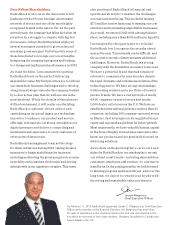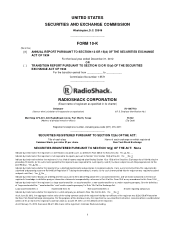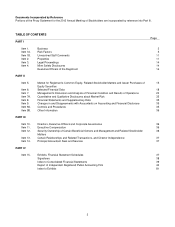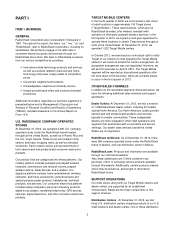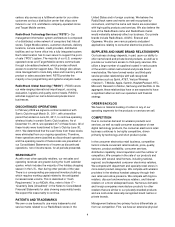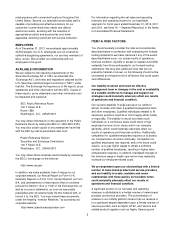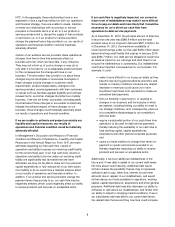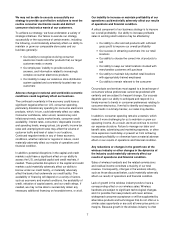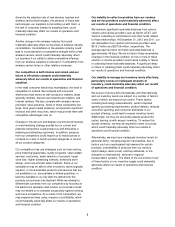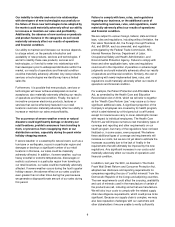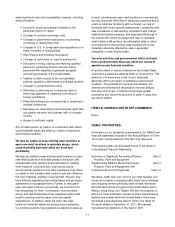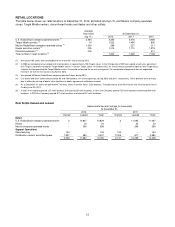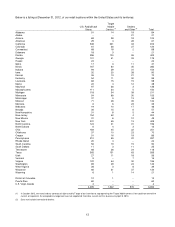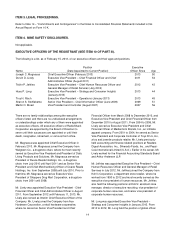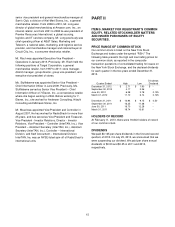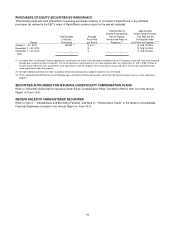Radio Shack 2012 Annual Report Download - page 8
Download and view the complete annual report
Please find page 8 of the 2012 Radio Shack annual report below. You can navigate through the pages in the report by either clicking on the pages listed below, or by using the keyword search tool below to find specific information within the annual report.
6
HTC. In the aggregate, these relationships have or are
expected to have a significant effect on both our operations
and financial strategy. If we are unable to create, maintain
or renew our relationships with our product or service
providers on favorable terms or at all, or if our product or
service providers limit or disrupt the supply of their products
or services to us, or if our product or service providers
change the payment terms they provide to us, our results of
operations and financial condition could be materially
adversely affected.
Certain of our wireless service providers make operational
changes from time to time that adversely affect our
business and over which we have little, if any, influence.
They may not inform us of such a change or may do so
only after it is too late for us to adequately predict and plan
for the consequences the change will have on our
business. The information they provide to us about these
changes may be incomplete or inaccurate. Examples of
these changes include changes to customer credit
requirements, product release dates, changes to the
service providers’ service agreements with their customers
on issues such as handset upgrade eligibility and contract
renewal terms, and other changes that affect our mobility
business. If we are not timely, accurately, and adequately
informed about these changes or are unable to effectively
mitigate the adverse impact of these changes on our
business, these changes could materially adversely affect
our results of operations and financial condition.
If we are unable to estimate and project accurately our
liquidity and capital resources, our results of
operations and financial condition could be materially
adversely affected.
In Management’s Discussion and Analysis of Financial
Condition and Results of Operations—Liquidity and Capital
Resources in this Annual Report on Form 10-K, we make
estimates regarding our free cash flow, results of
operations and ability to access our revolving credit facility
for the current fiscal year. If our free cash flow, results of
operations and ability to borrow under our revolving credit
facility are significantly less favorable than we have
estimated, we may not be able to make all of our planned
capital expenditures or fully execute all of our other plans.
Our inability to do so could have a material adverse effect
on our results of operations and financial condition. In
addition, if our product and service providers change the
payment terms they provide to us, our cash flow may be
negatively affected, which could negatively affect our ability
to receive products and services on acceptable terms.
If our cash flow is negatively impacted, our current or
future level of indebtedness may make it more difficult
for us to pay our debts and more likely that it would be
necessary for us to divert our cash flow from
operations to debt service payments.
As of December 31, 2012, the principal amount of debt due
in less than one year was $286.9 million and the total
principal value of our long-term debt was $501.0 million. As
of December 31, 2012, the maximum availability of
revolving borrowings under our five-year $450 million asset-
based revolving credit facility that expires in January 2016
was $393.7 million. Our debt service obligations could have
an adverse impact on our earnings and cash flows for as
long as the indebtedness is outstanding. Our indebtedness
could have important consequences for our business. For
example, it could:
• make it more difficult for us to pay our debts as they
become due during general adverse economic and
market or industry conditions, because any related
decrease in revenues could cause us to have
insufficient cash flows from operations to make our
scheduled debt payments;
• limit our flexibility in planning for, or reacting to,
changes in our business and the industry in which
we operate, including limiting our ability to invest in
our strategic initiatives, and, consequently, place us
at a competitive disadvantage to our competitors
with less debt;
• require a substantial portion of our cash flows from
operations to be used for debt service payments,
thereby reducing the availability of our cash flow to
fund working capital, capital expenditures,
acquisitions and other general corporate purposes;
and
• cause our trade creditors to change their terms for
payment on goods and services provided to us,
thereby negatively impacting our ability to receive
products and services on acceptable terms.
Additionally, if we incur additional indebtedness in the
future and, if new debt is added to our current debt levels,
the risks above could intensify. Additional debt would
further increase the possibility that we may not generate
sufficient cash to pay, when due, interest on and other
amounts due in respect of our indebtedness, and would
further reduce our funds available for operations, working
capital, capital expenditures, acquisitions and other general
purposes. Additional debt may also decrease our ability to
refinance or restructure our indebtedness, and further limit
our ability to adjust to changing market conditions. If we or
our subsidiaries add new debt to our current debt levels,
the related risks that we and they now face could increase.


